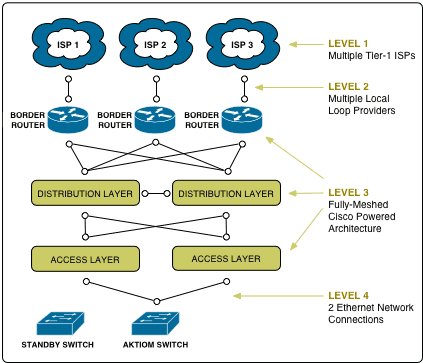What is Switch?
Switch is the very important device for a network. Switches present the features and technologies that can be used to respond to the requirements on emerging network design. Some basic operations and technologies of switches are given below:
- Fast Convergence: Switches stipulate that the network must adapt quickly to network topology changes.
- Deterministic Paths: Switches provide desirability of a given path to a destination for certain applications or user groups.
- Deterministic Failover: Switches specify that a mechanism be in place to ensure that the network is operational all the times.
- Scalable Size and Throughput: Switches provide the infrastructure that must handle the increased traffic demands.
- Centralized Applications: Switches dictate that the centralized applications be available to support most or all users on the network.
- The New 20/80 Rule: This feature of the switches focus on the shift in traditional traffic patterns.
- Multiprotocol Support: Switches support multiprotocol environment for the campus network.
- Multicasting: Switches support IP multicast traffic in addition to IP unicast traffic for the campus network.Cisco Switches:

Cisco switches provide the robust internetworking solution. Cisco presents its switches product list for all kinds of switching such as LAN switches, Ethernet switches and ATM switches etc. Cisco makes its switches highly modular from a hardware and software perspective. Functions that routers once performed, switches are now performing. Selection of Cisco switch products at a specific layer depends on the required functionality of each device.
- Cisco Switches for Access Layer:
- The Catalyst 1900 or 2820 series switch is an effective access device in a small or medium network.
- The Catalyst 2900 series switch is also effective in providing network access to server clusters and or end user populations (less than 50 users).
- The Catalyst 4000 series provides an advanced high performance enterprise switching solution and leverages a multigigabit architecture for 10/100/1000 Mbps Ethernetswitching.
- The Catalyst 5000 series is an effective device in a large network that need to provide network access for more then 100 end users. It also supports 10/100/1000 MbpsEthernet switching.Cisco Switches for Distribution Layer:
- The Catalyst 5000 series and 2926G switches are the most effective distribution switch devices because they participate in multilayer switching with a route processor. For Layer 3 switching, Catalyst 5000 series supports internal route processor module and 2926G switch works with an external route such as 400 and 700 series routers.
- The Catalyst 6000 switches are effective at the distribution level, where user require very high densities of Fast or Gigabit Ethernet.Cisco Switches for Core Layer:
- The Catalyst 6500 and 8500 series switches are very effective at the core backbone implementations. They provide wire speed multicast forwarding and routing, as well as the Protocol Independent Multicast (PIM) protocol for scalable multicast routing. They are ideal for aggregating multiprotocol traffic from multi wiring closet or from work group switches.SwitchingLAN switching and multilayer switching is rewarding the contour lines of internetworking. Switches operate switching by building and maintaining switching table. The switching table consists of MAC layer addresses. The core information in a switching table is:
- Destination MAC address
- VLAN membership of destination MAC address
Port destination MAC address learned fromAs mentioned above, the switching table contains three units of information for each entry that is destination MAC address, VLAN number that the MAC address is a member and the port to switch frames out of to get to the destination MAC address. If a frame is received with a destination MAC address contained with, the frame will get forwarded out to the given destination. If a frame is received with a destination MAC address is not in the switching table, the frame get broadcast out to all outbound ports of the VLAN.Switching TypeThere are three main types of switching such as: - Store and Forward Switching: In this type of switching, complete frame is received and checked before forwarding.
- Cut through Switching: In this type of switching, switch check only destination address and immediately forward the frame.
- Fragment free switching: This is also known as modified cut through and in this type of switching, switch checks the first 64 bytes and then immediately forward the frame.Cisco File Transfer between SwitchesThe condition of making each port on a switch a separate collusion domain is known as "micro segmenting". By default, all ports on an entire switch are in a single broadcast domain. On a switch, broadcast domains are defined by VLANs. One VLAN defines a single broadcast domain. It traffic needs to be forwarded from one VLAN to another, a routing process must be used to route "inter-VLAN" traffic. However, LAN switches do not have the intelligence to move traffic from one VLAN to another. This is the role of Cisco router in a switched internetwork. Routers are used to switched packets between VLANs and perform file transfer between switches.When multiple LAN switches are interconnected with multiple connections to the other switches, a loop topology may be formed. A looped topology is often desirable to provide redundancy, but looped traffic is undesirable. Spanning Tree Protocol (STP) is designed to prevent such loops from being formed. The Spanning Tree Protocol has four basic phases of operation:
- Election of root bridging among a switch group on a per VLAN basis.
- Calculating the shortest path to the root switch by all non-root switches within a specific VLAN.
- Block highest cost paths to the root switch for loop avoidance if a loop exists.
- Maintaining and recalculating the spanning tree with BPDUs on a per VLAN basis.
Related Articles



0 comments:
Post a Comment